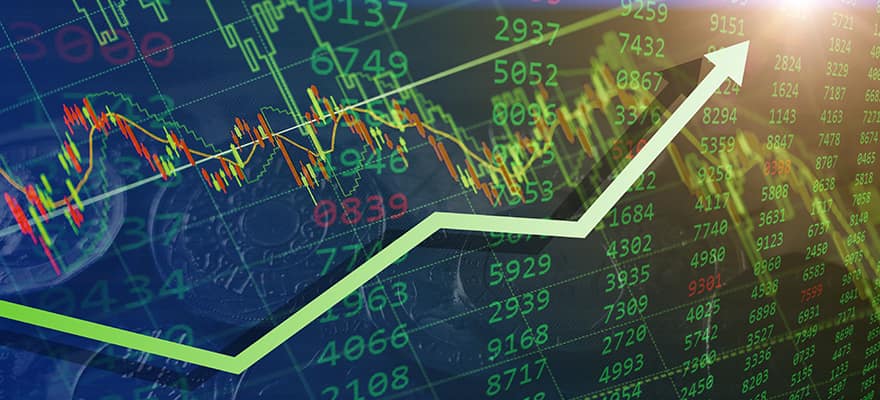This week, the Australian Securities and Investments Commission (ASIC) released a report on retail trading of securities and contracts for difference (CFD) amid the coronavirus pandemic, revealing an uptick in both client accounts and client losses.
The report was based on data from 12 CFD providers within Australia that make up about 84 percent of the market share, so we reached out to some retail brokers within the country to see if this report is reflective of what they have been experiencing.
As Finance Magnates reported on Wednesday, ASIC said that during the focus period, which spans from the 24th of February to the 3rd of April this year, there was a sharp uptick in the daily number of unique client identifiers, which are indicative of new client accounts, associated with retail brokers. This is appearing for the first time in ASIC’s trade surveillance data.
During the focus period, an average of 4,675 new identifiers appeared per day, which made up a total of 140,241 identifiers ASIC had previously not observed. During the six months prior to the focus period, the authority observed 1,369 new identifiers per day and an average of 34,502 new identifiers appearing in a period of the same length.
Aussie brokers see an uptick in clients and volumes
ASIC also witnessed a large number of ‘dormant’ client identifiers from retail brokers. These dormant investors had not traded during the preceding six months but became active again during the focus period.
Speaking to Finance Magnates, Christopher Gore, the Chief Executive Officer of FX broker GO Markets, said: “The paper’s observation relating to new clients and increased trading volumes is broadly consistent with what we’ve seen. It would, however, be interesting to see a broader focus period to understand the impact on client P&L over time. I suspect the data may reveal a smoothing of P&L in the ensuing weeks of the focus period.”
ACY Securities, a Forex
Forex
Foreign exchange or forex is the act of converting one nation’s currency into another nation’s currency (that possesses a different currency); for example, the converting of British Pounds into US Dollars, and vice versa. The exchange of currencies can be done over a physical counter, such as at a Bureau de Change, or over the internet via broker platforms, where currency speculation takes place, known as forex trading.The foreign exchange market, by its very nature, is the world’s largest tradi
Foreign exchange or forex is the act of converting one nation’s currency into another nation’s currency (that possesses a different currency); for example, the converting of British Pounds into US Dollars, and vice versa. The exchange of currencies can be done over a physical counter, such as at a Bureau de Change, or over the internet via broker platforms, where currency speculation takes place, known as forex trading.The foreign exchange market, by its very nature, is the world’s largest tradi
Read this Term broker based in Australia, told Finance Magnates that it has continued to see significant increases in both new accounts and trading volumes in 2020. Specifically, the broker saw a 60 percent increase in accounts and a 45 percent increase in volumes during the month of March.
For the following month, April 2020, ACY Securities has continued this momentum, with a 35 percent growth in accounts and a 55 percent uptick in trading volumes.
Towards the end of March, Vantage FX, another Australian-based broker, revealed to Finance Magnates in a previous interview that it had seen quite an increase in trading activity as well as onboarding interest over the prior few weeks.
GO Markets: further studies are needed
Although ASIC’s report does provide some good insight into the current situation in Australia, it is only looking at a six week period, and therefore, provides a snapshot of the current situation. With restrictions likely to remain in place in some shape or form for a while, and the COVID-19 pandemic will still pose a threat for months to come, market Volatility
Volatility
In finance, volatility refers to the amount of change in the rate of a financial instrument, such as commodities, currencies, stocks, over a given time period. Essentially, volatility describes the nature of an instrument’s fluctuation; a highly volatile security equates to large fluctuations in price, and a low volatile security equates to timid fluctuations in price. Volatility is an important statistical indicator used by financial traders to assist them in developing trading systems. Traders
In finance, volatility refers to the amount of change in the rate of a financial instrument, such as commodities, currencies, stocks, over a given time period. Essentially, volatility describes the nature of an instrument’s fluctuation; a highly volatile security equates to large fluctuations in price, and a low volatile security equates to timid fluctuations in price. Volatility is an important statistical indicator used by financial traders to assist them in developing trading systems. Traders
Read this Term will remain.
As Finance Magnates explored in the Virtual Leaders Roundtable webinar, FX volatility is here to stay. After being asked how long recent levels of heightened volatility might persist, the speakers agreed that it wouldn’t disappear as soon as the lockdown measures end.
As highlighted by Andrew Edwards, the CEO of Saxo Markets UK, the longer the lockdown measures continue, the larger the damage there will be to the global economy. Once we are out of lockdown, then there will be a recovery period – government intervention, mergers, and acquisitions, etc., and uncertainty will persist – and where there’s uncertainty, there is volatility.
“I’m not sure we’ll see the same knee jerk reaction volatility we have seen over March and April, but we’re certainly in a new norm, and whilst that uncertainty exists, that volatility will be high… at least until the end of the year. I think if this lockdown goes beyond June, then I think we’re in for a tough time and a volatile time well into next year,” Edwards added.
“The paper also serves as a reminder of consumer demand for speculative products despite what are highly uncertain times. It would be interesting to see further studies on this,” continued Gore from GO Markets. “ASICs paper highlight the importance of being vigilant amid unprecedented market turmoil. We’ve engaged with our clients directly to highlight the material increase in volatility.”
This week, the Australian Securities and Investments Commission (ASIC) released a report on retail trading of securities and contracts for difference (CFD) amid the coronavirus pandemic, revealing an uptick in both client accounts and client losses.
The report was based on data from 12 CFD providers within Australia that make up about 84 percent of the market share, so we reached out to some retail brokers within the country to see if this report is reflective of what they have been experiencing.
As Finance Magnates reported on Wednesday, ASIC said that during the focus period, which spans from the 24th of February to the 3rd of April this year, there was a sharp uptick in the daily number of unique client identifiers, which are indicative of new client accounts, associated with retail brokers. This is appearing for the first time in ASIC’s trade surveillance data.
During the focus period, an average of 4,675 new identifiers appeared per day, which made up a total of 140,241 identifiers ASIC had previously not observed. During the six months prior to the focus period, the authority observed 1,369 new identifiers per day and an average of 34,502 new identifiers appearing in a period of the same length.
Aussie brokers see an uptick in clients and volumes
ASIC also witnessed a large number of ‘dormant’ client identifiers from retail brokers. These dormant investors had not traded during the preceding six months but became active again during the focus period.
Speaking to Finance Magnates, Christopher Gore, the Chief Executive Officer of FX broker GO Markets, said: “The paper’s observation relating to new clients and increased trading volumes is broadly consistent with what we’ve seen. It would, however, be interesting to see a broader focus period to understand the impact on client P&L over time. I suspect the data may reveal a smoothing of P&L in the ensuing weeks of the focus period.”
ACY Securities, a Forex
Forex
Foreign exchange or forex is the act of converting one nation’s currency into another nation’s currency (that possesses a different currency); for example, the converting of British Pounds into US Dollars, and vice versa. The exchange of currencies can be done over a physical counter, such as at a Bureau de Change, or over the internet via broker platforms, where currency speculation takes place, known as forex trading.The foreign exchange market, by its very nature, is the world’s largest tradi
Foreign exchange or forex is the act of converting one nation’s currency into another nation’s currency (that possesses a different currency); for example, the converting of British Pounds into US Dollars, and vice versa. The exchange of currencies can be done over a physical counter, such as at a Bureau de Change, or over the internet via broker platforms, where currency speculation takes place, known as forex trading.The foreign exchange market, by its very nature, is the world’s largest tradi
Read this Term broker based in Australia, told Finance Magnates that it has continued to see significant increases in both new accounts and trading volumes in 2020. Specifically, the broker saw a 60 percent increase in accounts and a 45 percent increase in volumes during the month of March.
For the following month, April 2020, ACY Securities has continued this momentum, with a 35 percent growth in accounts and a 55 percent uptick in trading volumes.
Towards the end of March, Vantage FX, another Australian-based broker, revealed to Finance Magnates in a previous interview that it had seen quite an increase in trading activity as well as onboarding interest over the prior few weeks.
GO Markets: further studies are needed
Although ASIC’s report does provide some good insight into the current situation in Australia, it is only looking at a six week period, and therefore, provides a snapshot of the current situation. With restrictions likely to remain in place in some shape or form for a while, and the COVID-19 pandemic will still pose a threat for months to come, market Volatility
Volatility
In finance, volatility refers to the amount of change in the rate of a financial instrument, such as commodities, currencies, stocks, over a given time period. Essentially, volatility describes the nature of an instrument’s fluctuation; a highly volatile security equates to large fluctuations in price, and a low volatile security equates to timid fluctuations in price. Volatility is an important statistical indicator used by financial traders to assist them in developing trading systems. Traders
In finance, volatility refers to the amount of change in the rate of a financial instrument, such as commodities, currencies, stocks, over a given time period. Essentially, volatility describes the nature of an instrument’s fluctuation; a highly volatile security equates to large fluctuations in price, and a low volatile security equates to timid fluctuations in price. Volatility is an important statistical indicator used by financial traders to assist them in developing trading systems. Traders
Read this Term will remain.
As Finance Magnates explored in the Virtual Leaders Roundtable webinar, FX volatility is here to stay. After being asked how long recent levels of heightened volatility might persist, the speakers agreed that it wouldn’t disappear as soon as the lockdown measures end.
As highlighted by Andrew Edwards, the CEO of Saxo Markets UK, the longer the lockdown measures continue, the larger the damage there will be to the global economy. Once we are out of lockdown, then there will be a recovery period – government intervention, mergers, and acquisitions, etc., and uncertainty will persist – and where there’s uncertainty, there is volatility.
“I’m not sure we’ll see the same knee jerk reaction volatility we have seen over March and April, but we’re certainly in a new norm, and whilst that uncertainty exists, that volatility will be high… at least until the end of the year. I think if this lockdown goes beyond June, then I think we’re in for a tough time and a volatile time well into next year,” Edwards added.
“The paper also serves as a reminder of consumer demand for speculative products despite what are highly uncertain times. It would be interesting to see further studies on this,” continued Gore from GO Markets. “ASICs paper highlight the importance of being vigilant amid unprecedented market turmoil. We’ve engaged with our clients directly to highlight the material increase in volatility.”






















